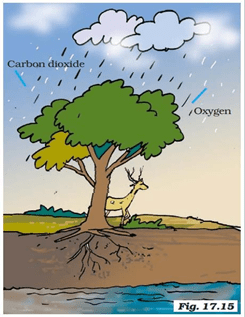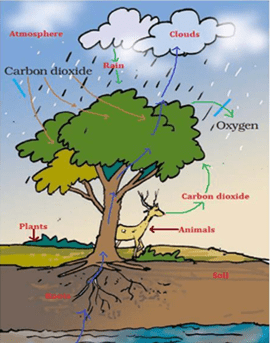NCERT Solutions Class 7 Science Chapter 12 Forests: Our Lifeline is provided here to help students in understanding the topic thoroughly. All these solutions are solved by experts with a detailed explanation. Class 7 NCERT Solutions for Science Chapter 12 includes all the textbook exercise questions and answers. These solutions will help students complete their assignments & homework.
Class 7 Science Forests: Our Lifeline Questions and Answers
Exercise Questions
Question 1: Explain how animals dwelling in the forest help it grow and regenerate.
Answer: Animals dwelling in the forest help it grow and regenerate in the following ways
- Animals help in dispersing plant seeds.
- Decaying animal dung provides nutrients for plants to grow
- Microorganisms convert the dead plants and animals to humus
Question 2: Explain how forests prevent floods.
Answer: Forest acts as a natural absorber of water. It allows rain water to seep through. In the absence of trees, the rain water would hit the ground directly resulting in flood. However, because of the presence of trees, rain water does not hit the ground directly. It rather hits the ground slowly. Hence, before flooding, all the rain water seeps through ground. In this way, forests prevent floods.
Question 3: What are decomposers? Name any two of them. What do they do in the forest?
Answer 3: Decomposers are the organisms which feed on the dead bodies of plants and animals. Examples: Fungi and Bacteria. They clean the forests decaying dead bodies and replenishing the nutrients back to the forest soil.
Question 4: Explain the role of forest in maintaining the balance between oxygen and carbon dioxide in the atmosphere.
Answer: Plants release oxygen in the atmosphere during the process of photosynthesis. This oxygen is inhaled by the animals for respiration. During respiration, they release carbon-dioxide which is absorbed by plants. In this way the oxygen and carbon dioxide cycle goes on. Since forests contain a large number of plants, they help much in this cycle and maintain balance in nature.
Question 5: Explain why there is no waste in a forest.
Answer: Forests are excellent, perfect and natural recycling factories. All animals, whether herbivores or carnivores depend ultimately on plants for food. Herbivores eat plants and their products. Carnivores eat herbivores. Dead remains of animals and plants are decomposed by micro-organisms into humus. Whatever is produced in the forest is ultimately utilized by different components of the forest. Forests maintain a network of food chains called food web and hence nothing goes waste in a forest.
Question 6: List five products we get from forests?
Answer:
- Fruits and Vegetables
- Timber and wood
- Turpentine, latex (rubber raw product)
- Spices, resin, gum
- Medicines and herbs
Question 7: Fill in the blank:
(a) The insects, butterflies, honeybees and birds help flowering plants in _______.
(b) A forest is a purifier of _______ and ________.
(c) Herbs form the ________ layer in the forest.
(d) The decaying leaves and animal droppings in a forest enrich the _______.
Answer:
(a) pollination
(b) water, air
(c) lowest
(d) soil
Question 8: Why should we worry about the conditions and issues related to forests far from us?
Answer: We should worry about the forest for the following reasons.
- A decrease in forest results in an increase in Carbon dioxide content in the atmosphere this results in global warming.
- Depletion of forests results in soil erosion
- Decrease in forest adversely affect the lives of animals living in the forest.
- Absence of forests leads to flooding more often.
- Due to the reduction of forest land will turn barren which is called desertification.
Question 9: Explain why there is a need of variety of animals and plants in a forest.
Answer: A greater variety of plants and animals in the forests helps it to regenerate and grow. Greater variety of plants means more food and habitat for the herbivores. An increase in herbivores means more food for carnivores. Decomposers help to maintain the supply of nutrients to the soil and to the growing plants. This wide variety makes the forest a dynamic living entity.
Question 10: In Fig. 17.15, the artist has forgotten to put the labels and directions on the arrows. Mark the directions on the arrows and label the diagram using the following labels: Clouds, rain, atmosphere, carbon dioxide, oxygen, plants, animals, soil, roots, water table.

Answer:

Question 11: Which of the following is not a forest product?
(i) Gum
(ii) Plywood
(iii) Sealing wax
(iv) Kerosene
Answer: (iv) Kerosene
Question 12: Which of the following statements is not correct?
(i) Forests protect the soil from erosion.
(ii) Plants and animals in a forest are not dependent on one another.
(iii) Forests influence the climate and water cycle.
(iv) Soil helps forests to grow and regenerate.
Answer: (ii) Plants and animals in a forest are not dependent on one another.
Question 13: Micro-organisms act upon the dead plants to produce
(i) sand
(ii) mushrooms
(iii) humus
(iv) wood
Answer: (i) Humus
Having a good grasp over CBSE NCERT Solutions for Class 7 Science will further help the students in their preparation for board exams and other competitive exams. NCERT Solutions for Class 7 Science Chapter 12 Forests: Our Lifeline provided by CBSE Path help students to clear their doubts and to obtain good marks in the exams. All the solutions provided in this article are strictly based on the CBSE syllabus and curriculum.